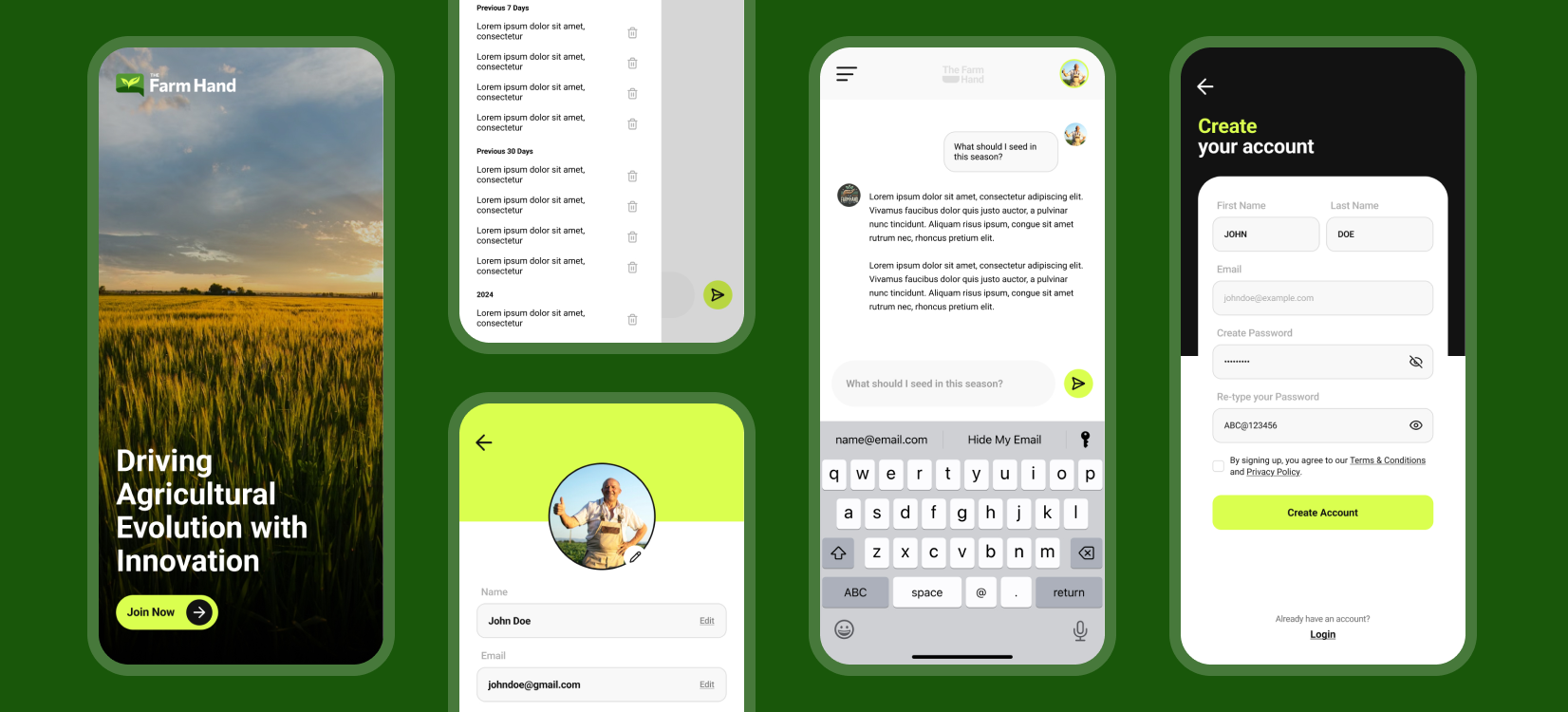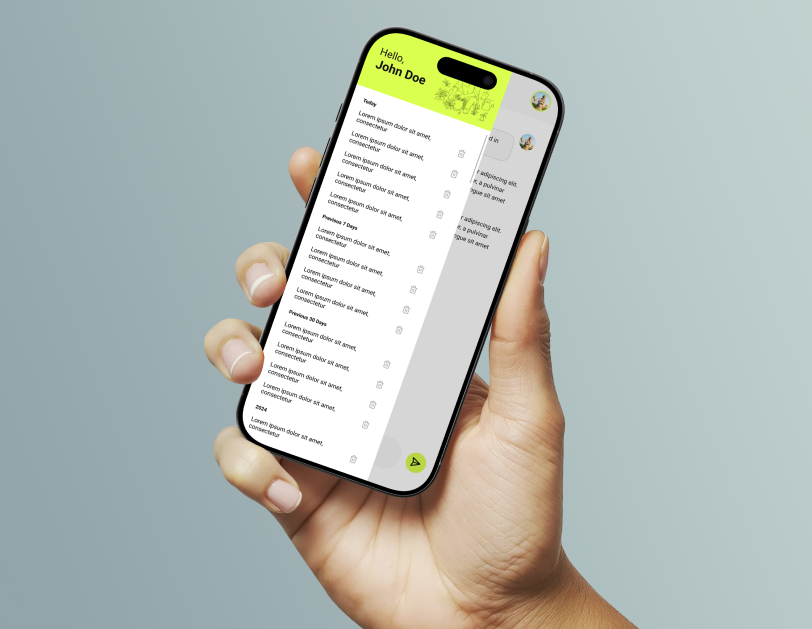3K +
Farmers Served50K
Acres Covered< 120 s
Response TimeYour AI Co-Pilot for Every Crop Cycle, Cultivating a Greener Future with Data-Driven Decisions.
We only collect information for business use as detailed in our Privacy Policy
From Client
The client aimed to build an intelligent digital companion for farmers, designed to revolutionize agricultural decision-making. Their goal was to create a tool that could accurately predict optimal planting windows by analyzing various environmental and historical farm data, thereby enhancing crop yield and operational efficiency. The client prioritized a solution that would be accessible and user-friendly for non-technical users (farmers) while being robust enough for future expansion.
Scope of Work:
- Data Integration: Fetch weather data from APIs (e.g., OpenWeatherMap, WeatherStack). Integrate soil temperature data from sensors or external sources. Allow farmers to upload their field-specific yield data (CSV or other formats).
- Backend Development: Build a database to store and process historical and real-time data. Implement logic for generating planting recommendations based on provided datasets.
- Frontend Development: Create a simple, user-friendly interface for data upload and displaying insights. Include basic visualizations like charts or tables to show recommendations.
- Prototype Goals: Focus on functionality over advanced features. Ensure the app is easy to use for non-technical users (e.g., farmers).
Requirements and Deliverables:
- Requirements: Proven experience with API integration. Proficiency in backend development (e.g., Python, Node.js, or similar). Familiarity with database systems (SQLite, PostgreSQL, or others). Frontend development skills (React, Vue.js, or other frameworks). Optional but helpful: Machine learning or predictive analytics experience.
- Deliverables: A functional prototype app with core features. Documentation for maintaining and scaling the app. Clear, commented code for future reference.
The result would be a transformative digital tool empowering farmers with data-driven insights for optimized planting and improved yields.

Goals and Objectives
To develop an intelligent, AI-powered chat assistant specifically designed to support farmers throughout their entire crop cycle, from planning and seeding to harvesting.
To enable farmers to interact with the assistant using natural language, eliminating the need for technical jargon or complex interfaces.
To provide instant, reliable information and data-driven advice on agronomic queries, backed by extensive agricultural research and field data.
To integrate the AI assistant with existing farm management platforms to offer personalized insights based on local weather conditions, soil analysis, and historical crop data.
To empower farmers with timely, accurate, and actionable information, thereby facilitating smarter decision-making and more efficient farm operations.
To create a system that continuously learns and improves from user interactions, ensuring its ongoing relevance and accuracy.
Solution We Provided
Our collaboration with a leading client in the agriculture sector led to the creation of the Farmhand AI-powered chat assistant. This digital companion serves as a comprehensive support system for farmers, guiding them through every stage of their crop cycle. We developed a robust AI agent capable of understanding and responding to natural language questions, allowing farmers to seek advice on various topics, including optimal planting times, effective pesticide application, and real-time diagnosis of crop issues.
The solution is designed to provide instant and reliable information, drawing from a vast knowledge base of agricultural research and field data. A key feature is its ability to integrate with farm management platforms, which enables the assistant to deliver highly personalized insights tailored to specific local weather patterns, soil conditions, and individual crop histories. This contextual intelligence helps farmers make more informed and efficient operational decisions. Our development process involved leveraging modern Natural Language Processing (NLP) and machine learning techniques, and we worked closely with agronomists and real-world farmers to ensure the tool's practicality, accuracy, and significant impact on agricultural productivity.
Challenges and Innovative Solutions:
1. Ensuring Agronomic Accuracy and Reliability:
Challenge: Providing consistently accurate and reliable agricultural advice is complex due to the variability of environmental factors, crop types, and farming practices.
Innovative Solution: We addressed this by establishing a rigorous data validation process, collaborating closely with experienced agronomists, and integrating the assistant with vast agricultural research databases and real-world field data. This multi-layered approach ensured that the advice provided was always scientifically sound and practically applicable.
2. Facilitating Natural Language Interaction for Diverse Queries:
Challenge: Farmers use diverse terminology and may phrase their questions in various ways, making it difficult for a traditional system to understand their intent without technical jargon.
Innovative Solution: We implemented advanced Natural Language Processing (NLP) and machine learning models, utilizing Large Language Models (LLMs) from providers like OpenAI and Anthropic. This enabled the system to comprehend the nuances of natural language, allowing farmers to interact intuitively and "in their own terms," regardless of their technical proficiency.
3. Delivering Personalized, Contextual Insights:
Challenge: General agricultural advice is often insufficient; farmers require personalized insights based on their specific farm's conditions, such as local weather, soil type, and historical data.
Innovative Solution: The assistant was engineered to integrate seamlessly with existing farm management platforms. This integration allows it to pull real-time, contextual data, enabling the delivery of highly personalized recommendations that are directly relevant to a farmer's unique situation.
4. Continuous Learning and Improvement:
Challenge: Agricultural knowledge is constantly evolving, and the AI needed to adapt and improve its responses over time.
Innovative Solution: We designed the system with continuous learning capabilities. By leveraging machine learning, the assistant analyzes user interactions and feedback, constantly refining its understanding, expanding its knowledge base, and enhancing the accuracy and relevance of its advice without requiring constant manual updates.
Technology Stack and Benefits:
Technology Stack:
- LLM (Large Language Models): The core AI engine for understanding natural language and generating contextually relevant responses.
- Python: The primary programming language for backend development, AI model integration, and data processing.
- OpenAI API: Utilized for advanced natural language understanding, summarization, and generation capabilities.
- Anthropic API: Employed to augment AI capabilities, providing diverse and robust conversational AI features.
- PostgreSQL: A powerful and reliable relational database used for storing structured agricultural data, user profiles, and interaction logs.
- Vector Database: Crucial for efficient storage and retrieval of high-dimensional embeddings generated from agricultural research and field data, enabling rapid and accurate knowledge base lookups for relevant advice.
Benefits:
- Advanced AI Intelligence: The integration of LLMs, OpenAI, and Anthropic APIs provides sophisticated natural language processing and generation, ensuring the chat assistant delivers highly accurate, intelligent, and contextually aware agricultural advice.
- Robust and Scalable Backend: Python offers a highly flexible and powerful environment for developing a scalable backend, capable of handling complex agricultural data processing and real-time query responses efficiently.
- Comprehensive Data Management: PostgreSQL provides a reliable and structured solution for managing vast amounts of farm-related data, while the Vector Database optimizes the storage and retrieval of complex agricultural knowledge, enabling faster and more precise recommendations.
- Continuous Enhancement: The architecture supports continuous learning, allowing the AI model to evolve and improve its accuracy and responsiveness based on ongoing user interactions and new agricultural data.
- Personalized Farmer Support: The ability to integrate with farm management platforms and leverage contextual data ensures that advice is not generic but highly personalized to each farmer's specific conditions, leading to better decision-making.
- Enhanced User Accessibility: The natural language interface makes the technology accessible to all farmers, regardless of their technical expertise, fostering wider adoption and impact.
The Farmhand project has resulted in a transformative tool that empowers farmers with critical, data-driven insights, streamlining their operations and contributing to more sustainable and productive agriculture.
Technology We Used


Have a vision using AI?
Let's discuss. NOW!

A PROJECT WITH CIZO?




 hello@cizotech.com
hello@cizotech.com +91 79907 01039
+91 79907 01039 


